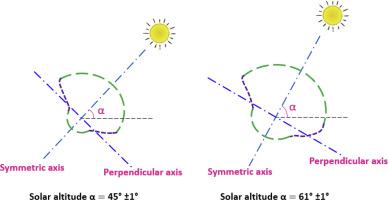当前位置:
X-MOL 学术
›
Remote Sens. Environ.
›
论文详情
Our official English website, www.x-mol.net, welcomes your
feedback! (Note: you will need to create a separate account there.)
In-situ spectroscopy and shortwave radiometry reveals spatial and temporal variation in the crown-level radiative performance of urban trees
Remote Sensing of Environment ( IF 11.1 ) Pub Date : 2021-02-01 , DOI: 10.1016/j.rse.2020.112231 Jie Deng , Brian J. Pickles , Li Shao
Remote Sensing of Environment ( IF 11.1 ) Pub Date : 2021-02-01 , DOI: 10.1016/j.rse.2020.112231 Jie Deng , Brian J. Pickles , Li Shao

|
Abstract In conventional microclimate environment modelling, and the development of tree planning strategies for urban heat mitigation, tree crown surface albedo for any given species is assumed to be a constant. However, our recent research into urban tree radiative performance at the crown level implied that tree crown surface albedo changes over time. Based on the in-situ spectroscopy protocols established previously to measure tree crown transflectance, variation in the characteristics of tree crown surface albedo was explored combining spectroscopy and solar shortwave radiometry. Three commonly planted native UK tree species, Carpinus betulus, Acer campestre, and Taxus baccata, were sampled. Spatial distribution profiles of tree crown transflectance measured at fixed solar altitudes were normalised by in-situ spectroradiometry. Tree crown transflectance in the near infrared (NIR) region was found to be proportionally linked to tree crown surface albedo. Within each species, mean tree crown transflectance in the NIR region of 800–900 nm was approximately 2.5 times tree crown surface albedo. It was further found that infrared radiation (700–2500 nm) accounted for more than 90% of the total transflected shortwave radiation from tree crowns. The results demonstrate that tree crown surface albedo linearly increases with momentary solar altitude and the maximum tree crown surface albedo corresponds to maximum solar altitude at solar noon on sunny days in summer. Tree crown surface albedo across species tends to be strongly dependent on leaf size if considering visibly dense crown foliage. Our findings provide important insights into tree radiative shading effects resulting from temporal variation in tree crown surface albedo, with consequences for urban microclimate modelling and the development of urban heat mitigation strategies.
中文翻译:

原位光谱和短波辐射测量揭示了城市树木树冠水平辐射性能的时空变化
摘要 在传统的小气候环境建模和城市热缓解树木规划策略的发展中,任何给定物种的树冠表面反照率都被假定为常数。然而,我们最近在树冠水平上对城市树木辐射性能的研究表明,树冠表面反照率随时间而变化。基于先前建立的用于测量树冠透反射的原位光谱协议,结合光谱学和太阳短波辐射测定法探索了树冠表面反照率特征的变化。对三种常见的英国本土树种 Carpinus betulus、Acer campestre 和 Taxus baccata 进行了采样。在固定的太阳高度测量的树冠透反射的空间分布剖面通过原位光谱辐射测定法进行归一化。发现近红外 (NIR) 区域的树冠透反射与树冠表面反照率成比例相关。在每个物种中,800-900 nm 近红外区域的平均树冠透反射率约为树冠表面反照率的 2.5 倍。进一步发现,红外辐射(700-2500 nm)占树冠总透反射短波辐射的 90% 以上。结果表明,树冠表面反照率随瞬时太阳高度线性增加,最大树冠表面反照率对应于夏季晴天中午太阳高度时的最大太阳高度。如果考虑到明显密集的树冠叶子,跨物种的树冠表面反照率往往强烈依赖于叶子的大小。
更新日期:2021-02-01
中文翻译:

原位光谱和短波辐射测量揭示了城市树木树冠水平辐射性能的时空变化
摘要 在传统的小气候环境建模和城市热缓解树木规划策略的发展中,任何给定物种的树冠表面反照率都被假定为常数。然而,我们最近在树冠水平上对城市树木辐射性能的研究表明,树冠表面反照率随时间而变化。基于先前建立的用于测量树冠透反射的原位光谱协议,结合光谱学和太阳短波辐射测定法探索了树冠表面反照率特征的变化。对三种常见的英国本土树种 Carpinus betulus、Acer campestre 和 Taxus baccata 进行了采样。在固定的太阳高度测量的树冠透反射的空间分布剖面通过原位光谱辐射测定法进行归一化。发现近红外 (NIR) 区域的树冠透反射与树冠表面反照率成比例相关。在每个物种中,800-900 nm 近红外区域的平均树冠透反射率约为树冠表面反照率的 2.5 倍。进一步发现,红外辐射(700-2500 nm)占树冠总透反射短波辐射的 90% 以上。结果表明,树冠表面反照率随瞬时太阳高度线性增加,最大树冠表面反照率对应于夏季晴天中午太阳高度时的最大太阳高度。如果考虑到明显密集的树冠叶子,跨物种的树冠表面反照率往往强烈依赖于叶子的大小。







































 京公网安备 11010802027423号
京公网安备 11010802027423号